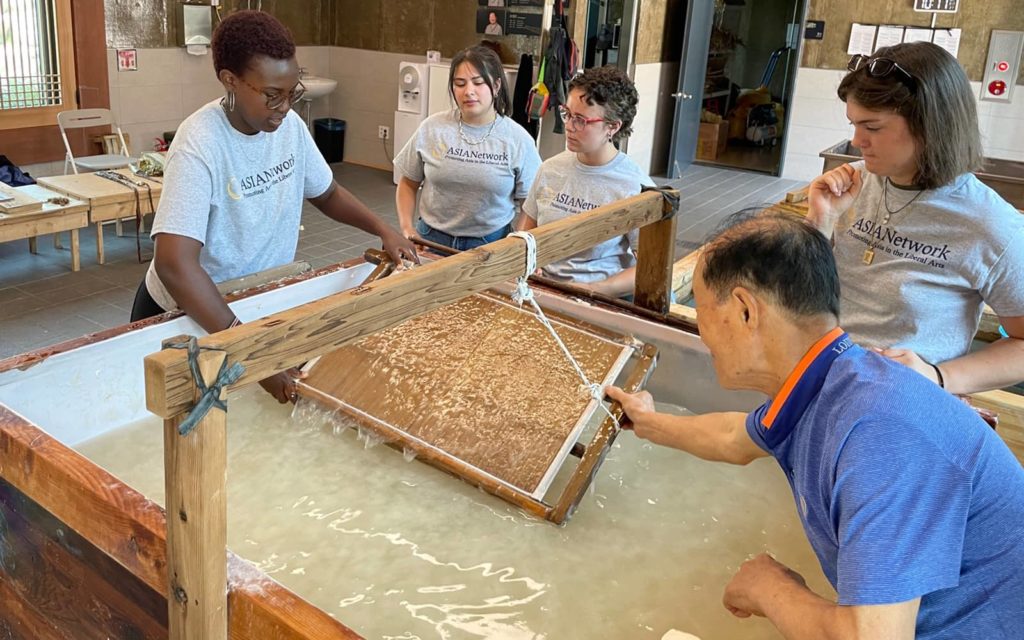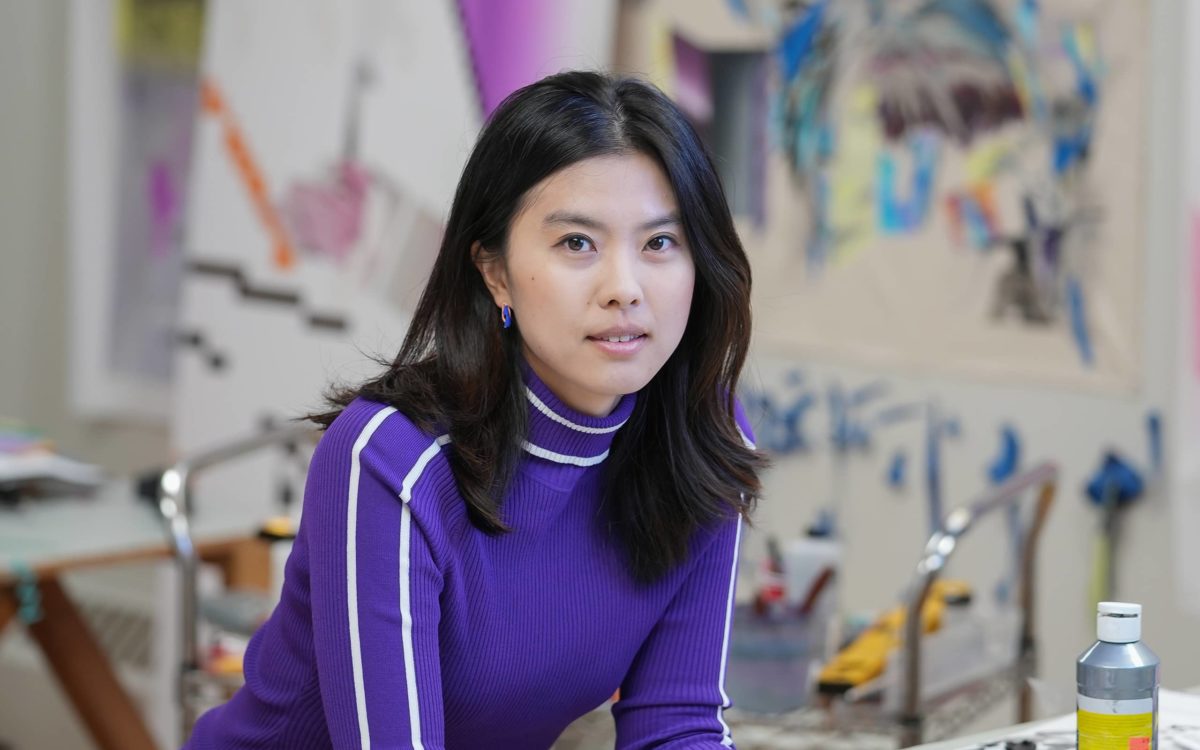Imaging What Can’t Be Seen
Leekyung Kang
There’s a paradox in Leekyung Kang’s art: She focuses on things we cannot see.
Opaque holes hover in some recent work. What do murky swaths of spray paint cover up? We see a brick foundation, but of what?
Kang finds unseen spaces intriguing. It dates to her childhood in Seoul, South Korea. From her apartment windows she watched a constant stream of deconstructions — buildings razed and new ones built. “You see scaffolding and hidden structures at first, but then it’s going to be covered by the outside material. As an artist I was very inspired by facades and building structures in an aesthetic way. I was always curious about unseen space, which is always there, but never fully present,” she says.
An assistant professor of art, Kang joined the Hope faculty in 2021 after teaching for three years at Idaho State University. During one of those summers, she was the Borgeson Artist in Residence at Hope. She teaches drawing and printmaking.
While printmakers typically create limited editions of a screenprint, etching, woodcut or other type of print — numbered identical prints of a single piece — Leekyung Kang often produces a single work of art because she elaborates the printed image.
Screenprinting is one technique in print media. Amid racks of her students’ work, she uses the printmaking studio in the De Pree Art Center to create base layers of her pieces on paper, forcing paint through fine mesh screens and stencils. Then she adds details digitally, including squiggles of color that seem to have been done by hand.
With acrylic paint, crayons, and spray paint, she continues to add shapes and blocks and bands of color over printed images — usually abstract, but with an occasional realistic element. “I always want to go beyond one medium to another medium,” she says. While printmakers typically create limited editions of a screenprint, etching, woodcut or other type of print—numbered identical prints of a single piece – Kang often produces a single work of art because she elaborates the printed image.
In college in Korea, Kang studied painting. As she continued her training in graduate programs there and at the Rhode Island School of Design (RISD) she incorporated blueprints and manuscripts in her work, then gravitated toward the tools she currently employs to create conceptual art that implies digital surfaces and the randomness of our internet presence, as she phrases it.
“Now I’m interested in in-between spaces — from digital to invisible, reality to non-reality,” she says. “I have to use a digital and photographic image. I need to use those references for my work, geometric structures.”
While earning an M.F.A. at RISD, Kang also took courses at nearby Brown University in modern culture and media. Provocative questions about artificial intelligence and other aspects of technology are central to her art, issues probed by philosophers as disparate as Plato and the 20th-century French philosopher George Bataille (whose respective cave allegory and waste theory she finds apt frameworks for the issues that engage her imagination). A remarkable artist residency in 2021 brought those ideas into her experiential realm.
Kang was selected as the 2021 artist in residence at the Sanford Underground Research Facility, a laboratory in South Dakota that’s 1,490 meters below the surface. In 12 miles of tunnels, physicists, geologists and others conduct research that must be shielded from cosmic rays.
Scientists there talked about a reflected version of our own universe. “That sounds very fascinating, but we don’t really know what it is,” Kang reflects. “I haven’t seen it. There’s some version of our universe, and I don’t even know where it is. In real time and space we only get to see what’s available, but what’s beyond reality, and how do I see that area that I don’t get to see in time and space?
“When I was able to go down to the underground area, all of a sudden it occurred to me: What if the cave was inverted or reverted? Underground, I got out of real time-space into an underground space, but one I’ve never been in. I was kind of confused about the exit and entrance — where was I located, myself? Is it possible to define what space is reality and what is not?”
This spring as she prepared for a solo gallery exhibition in Seoul, Kang taped 2-D works in progress to her office wall and added to them bit by bit. “I don’t really stick to one painting till I finish. I kind of move on. Often several pieces will have very similar elements — similar marks I try to create on purpose. I try to get repetition; they’re echoing back to each other,” she says.

Thanks to a $25,000 grant from the ASIANetwork, which promotes education about Asia at American liberal arts colleges, when Kang left for Seoul in June, four Hope students accompanied her: studio art majors Isabella Gaetjens-Oleson ’23 and Joanna Locke ’24, art history major Madi Huerta ’23, and physical and health education major Ayanna Njoroge ’24. One purpose of their three-week trip was to experience Seoul’s contemporary art scene and use printmaking resources beyond what they’d worked with before. Another was to explore East Asian art, history, and the history of printmaking in the context of Korean Buddhist temples and culture. At a UNESCO cultural heritage site, with Kang they viewed woodblock prints made some 800 years ago. They stayed overnight in a Buddhist temple “to learn about temple manners,” Kang explains. Then, in a printmaking studio in Seoul, they made work out of that inspiration.
Three of the students returned to the United States in late June. Locke stayed in Seoul with Kang to assist her during her month-long show at GOP Gallery in Seoul, and then accompanied her to Brooklyn, New York, where Kang is spending the balance of the summer immersed in a Kunstraum artist residency. She’ll teach on campus this fall, but will make several trips to New York until the residency concludes in late September.
View more of Leekyung Kang’s art at kangleekyung.com.


